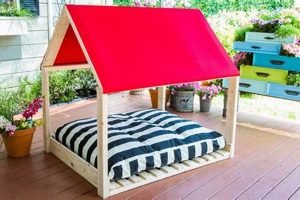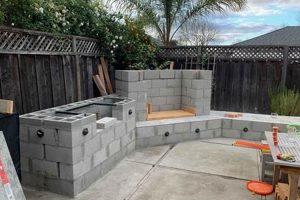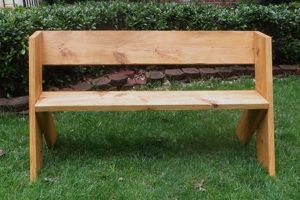Fabricating protective layers for patio sets, benches, and other exterior furnishings through personal construction constitutes a cost-effective approach to preservation. This method involves selecting appropriate materials, measuring dimensions, cutting fabric, and employing sewing techniques to create tailored shields against environmental elements. An example includes crafting a water-resistant sheet to protect a dining table and chairs during inclement weather.
Shielding exterior furnishings from rain, sun, and debris extends their lifespan, mitigates fading, and reduces the frequency of cleaning or restoration. Historically, resourceful individuals have improvised methods of protection; contemporary adoption of this practice allows for customization, precise fit, and selection of performance-oriented textiles, ultimately saving replacement costs and preserving aesthetic appeal.
The subsequent discussion will elaborate on material selection, measurement techniques, construction methods, and maintenance strategies relevant to successfully creating durable and effective protective coverings for exterior appointments.
Fabrication Insights for Protective Exterior Furnishing Layers
The creation of durable and effective coverings for exterior appointments requires careful planning and execution. The following recommendations enhance the likelihood of a successful project.
Tip 1: Material Selection: Prioritize textiles designed for outdoor use. Water resistance, UV resistance, and breathability are crucial characteristics. Canvas, treated polyester, and solution-dyed acrylic fabrics offer superior performance compared to standard textiles.
Tip 2: Precise Measurement: Accurate dimensions are paramount. Measure the furniture at its widest and tallest points. Add several inches to each dimension to facilitate easy installation and removal of the covering. Consider seam allowances in measurements.
Tip 3: Pattern Creation: Develop a pattern, either by draping fabric directly on the furniture or by using existing templates. A well-defined pattern ensures a tailored fit and minimizes fabric waste. Mark seam lines and fastening points clearly.
Tip 4: Seam Construction: Employ robust sewing techniques. Reinforced seams, such as flat-felled or double-stitched seams, enhance the durability and water resistance. Utilize outdoor-grade thread designed to withstand UV exposure and moisture.
Tip 5: Fastening Mechanisms: Integrate secure fastening systems. Options include drawstrings, buckles, Velcro straps, or elastic hems. The chosen mechanism should prevent the covering from being displaced by wind or other environmental factors. Ensure fasteners are corrosion-resistant.
Tip 6: Ventilation: Incorporate ventilation features. Small vents or breathable fabric panels prevent the buildup of moisture and mildew beneath the covering. Strategically position vents to minimize water ingress.
Tip 7: Reinforcement: Reinforce high-stress areas. Corners and edges are particularly vulnerable to wear and tear. Add extra layers of fabric or binding tape to these areas to enhance longevity.
Effective production of protective layers necessitates attention to detail and the use of appropriate materials. Adherence to these recommendations will extend the lifespan of exterior furnishings and minimize the need for frequent replacements.
The subsequent section will provide detailed instructions on specific fabrication techniques, including cutting, sewing, and finishing.
1. Material water resistance
Material water resistance constitutes a fundamental requirement for any covering intended to protect outdoor furnishings. Its effectiveness directly correlates with the longevity and aesthetic preservation of the furniture beneath. Selecting fabrics lacking inherent or applied water resistance compromises the primary purpose of the covering.
- Preventing Moisture Absorption
Water-resistant materials prevent the absorption of moisture into the furniture frame, cushions, and other components. Moisture ingress promotes rot, mildew growth, and degradation of structural integrity. For instance, untreated wood furniture exposed to prolonged wet conditions deteriorates rapidly, necessitating costly repairs or replacement.
- Reducing Staining and Discoloration
Water resistance minimizes the risk of staining and discoloration caused by rain, spills, or environmental contaminants. Fabrics treated with water-repellent finishes create a barrier that prevents liquids from penetrating the material fibers. A concrete example would be coffee spilled on an outdoor cushion protected with a water resistant covering, which can be easily wiped off, but when unprotected coffee can create a stain.
- Maintaining Cushion Integrity
Waterlogged cushions lose their shape, support, and comfort. Water-resistant coverings prevent saturation of cushion fillings, preserving their original form and resilience. Consider a patio chair cushion: When exposed to rain, it may become soaked. A water-resistant furniture cover prevents this from happening.
- Extending Furniture Lifespan
By mitigating moisture-related damage, water-resistant coverings contribute significantly to extending the overall lifespan of outdoor furniture. Protective covering acts as a barrier between the elements and the furniture, minimizing deterioration and preserving its functionality and appearance. Furniture that is protected from the elements lasts longer.
The selection of inherently water-resistant fabrics, such as solution-dyed acrylics, or the application of durable water repellent (DWR) finishes to other textiles, is paramount for effectively shielding outdoor furniture from the detrimental effects of moisture. Integration of water resistance serves as a preventative measure, safeguarding investment in exterior furnishings and minimizing maintenance requirements.
2. Accurate dimensioning
Precise measurement forms the foundation for effective fabrication of protective coverings for outdoor furnishings. Deviations from accurate dimensions compromise the fit, functionality, and protective capacity of the finished product.
- Optimizing Material Usage
Precise measurements minimize fabric waste. Accurate dimensions permit efficient pattern layout, reducing excess material. For example, imprecise measurements necessitate purchasing additional fabric to compensate for errors, increasing project costs and generating unnecessary textile waste.
- Ensuring Proper Fit
Accurate dimensions guarantee a tailored fit that conforms to the contours of the furniture. A well-fitted covering provides complete protection and prevents pooling of water or accumulation of debris. Conversely, inaccurately sized coverings may be too tight, causing stress on seams, or too loose, allowing environmental elements to penetrate.
- Facilitating Ease of Installation and Removal
Correctly measured coverings are easier to install and remove. Adequate allowance for seam allowances and ease of movement ensures the covering slides on and off the furniture smoothly. Insufficient allowance may result in coverings that are difficult to manipulate, increasing the risk of damage during installation or removal.
- Enhancing Aesthetic Appeal
Precise dimensions contribute to the overall aesthetic appeal of the covering. A well-fitted cover presents a neat and professional appearance, enhancing the visual integration with the outdoor environment. Inaccurately measured coverings can appear ill-fitting and detract from the aesthetic value of the furniture and surrounding space.
The integration of accurate dimensioning into the creation process for protective exterior furnishings is paramount for ensuring effective protection, optimized material usage, ease of application, and aesthetic integration. These benefits underscore the necessity of meticulous measurement techniques and attention to detail throughout the fabrication process.
3. Seam construction integrity
Seam construction integrity is paramount in the context of crafting protective coverings for outdoor furnishings. Seams represent points of potential failure; therefore, their robustness dictates the overall performance and longevity of the covering.
- Thread Selection
The choice of thread significantly influences seam integrity. Outdoor-grade threads, typically composed of polyester or nylon, exhibit superior resistance to UV degradation, moisture, and abrasion. Conversely, standard cotton threads deteriorate rapidly when exposed to environmental elements, compromising seam strength and promoting fabric separation. For instance, utilizing UV-resistant thread ensures the seam remains intact despite prolonged sun exposure, preventing premature failure.
- Stitch Type and Density
The type of stitch employed and its density contribute directly to seam strength and water resistance. Lockstitches, known for their durability, provide a secure interlock of threads, minimizing the risk of unraveling. Increasing stitch density enhances seam strength and reduces the likelihood of water penetration. Example: a double-stitched seam with a high stitch count per inch offers greater protection against tearing and water ingress than a single-stitched seam with a lower density.
- Seam Reinforcement Techniques
Reinforcement techniques enhance the durability of seams in high-stress areas. Binding tape, edge finishing, and double-layered fabric application provide additional support and prevent fraying. A practical example involves reinforcing corners and edges of a covering with binding tape to withstand repeated stretching and abrasion.
- Waterproofing Seams
Effective waterproofing of seams prevents water penetration, preserving the underlying furniture from moisture damage. Seam sealing tapes or liquid seam sealants create a barrier that blocks water ingress through needle holes and fabric junctions. An illustration is the application of seam sealant to the interior seams of a covering to prevent rain from seeping through during inclement weather.
Integrating appropriate thread selection, stitch type, reinforcement techniques, and waterproofing measures into the creation process is critical for maximizing seam construction integrity. The careful execution ensures prolonged protective capacity, mitigates environmental damage, and increases the lifespan of outdoor furnishings.
4. Secure fastening
Secure fastening constitutes a critical component in the construction and utility of self-made outdoor furniture coverings. Its effectiveness determines the degree to which the covering remains in place, providing uninterrupted protection from environmental elements. Improper fastening compromises the integrity of the covering, rendering it susceptible to displacement by wind, animals, or general wear.
- Wind Resistance and Retention
The primary role of secure fastening is to prevent the covering from being dislodged during windy conditions. Strong gusts can lift and remove poorly secured coverings, exposing the furniture to rain, sun, and debris. For instance, a covering employing only loosely tied drawstrings is likely to detach during a moderate breeze, whereas a system utilizing buckles and straps would remain firmly in place. This ensures consistent protection, particularly during inclement weather.
- Protection Against Animal Intrusion
Effective fastening deters animals from accessing the furniture beneath the covering. Loose or unsecured edges provide opportunities for rodents, birds, or insects to nest or damage the furniture. A tightly secured cover with no openings prevents animals from entering and causing harm. The integration of robust fasteners, such as heavy-duty zippers or snap closures, reduces the risk of animal intrusion.
- Maintaining Aesthetic Integrity
Secure fastening contributes to the visual appeal of the covered furniture. A taut, well-secured cover presents a clean and organized appearance, enhancing the overall aesthetic of the outdoor space. Conversely, a loose or sagging cover detracts from the visual appeal and indicates a lack of care. Proper fastening, therefore, maintains the aesthetic integrity of both the furniture and its surroundings.
- Extending Cover Lifespan
Proper fastening reduces stress on the covering material, prolonging its lifespan. Loose or flapping covers experience increased wear and tear from wind and friction. Securing the cover prevents excessive movement, minimizing stress on seams and fabric. Secure fastening indirectly contributes to the longevity of the covering, reducing the frequency of replacement.
In summation, secure fastening mechanisms in DIY outdoor furniture coverings offer multifaceted benefits, encompassing weather resistance, animal deterrence, aesthetic enhancement, and extended material longevity. The strategic incorporation of robust fastening systems is paramount to achieving effective and durable protection for exterior furnishings.
5. Effective ventilation
Effective ventilation is a crucial, often overlooked, component in the design and construction of protective coverings for outdoor furniture. The absence of adequate ventilation promotes the accumulation of moisture beneath the cover, creating an environment conducive to mold and mildew growth. This, in turn, accelerates the degradation of both the furniture and the cover itself. A tightly sealed cover, while seemingly providing maximum protection from rain, can trap humidity arising from condensation, ground moisture, or residual dampness on the furniture surface. The result is often the formation of unsightly and potentially damaging mold colonies on cushions, wooden frames, and metal components. An example is the discovery of black mold on the underside of a dining chair after a period of prolonged enclosure with a non-ventilated cover, requiring extensive cleaning and potential restoration.
Achieving effective ventilation in self-fabricated furniture coverings involves several practical strategies. The incorporation of strategically placed vents, typically constructed from breathable mesh fabric, allows for air circulation while preventing the ingress of rain and debris. These vents should be positioned in areas that promote natural convection, such as near the top and bottom of the cover, facilitating the escape of warm, moist air. Another approach is the selection of breathable, water-resistant fabrics that allow moisture vapor to escape while repelling liquid water. An example would be utilizing a specialized outdoor fabric with microscopic pores that allow air to pass, helping to prevent moisture build-up and mold growth on the furniture.
In conclusion, effective ventilation is not merely an optional feature but an essential element in the design of durable and protective outdoor furniture coverings. By incorporating ventilation strategies, the damaging effects of moisture accumulation are mitigated, extending the lifespan of both the furniture and the cover. The challenges lie in balancing the need for ventilation with the desire for complete weather protection, requiring careful consideration of material selection and vent placement. Addressing this aspect ensures that self-fabricated coverings provide long-term protection and preserve the aesthetic and functional integrity of outdoor furnishings.
6. Reinforcement
Reinforcement, in the context of crafting self-fabricated outdoor furniture coverings, represents a critical measure to augment durability and extend the lifespan of these protective layers. These are inherently subject to environmental stressors. Strategic reinforcement addresses vulnerabilities, ensuring sustained performance.
- Corner and Edge Protection
Corners and edges of furniture coverings experience disproportionate wear due to friction, abrasion, and tension. Reinforcing these areas with additional fabric layers, binding tape, or specialized corner protectors mitigates the risk of tearing and fraying. An example includes applying heavy-duty canvas patches to the corners of a chair cover, preventing damage from rubbing against adjacent surfaces or sharp furniture edges.
- Seam Strengthening
Seams represent inherently weaker points in any sewn construction. Reinforcing seams, particularly those exposed to stress, enhances their resistance to separation and water penetration. Techniques include double-stitching, flat-felled seams, and the application of seam tape. A practical example is implementing a flat-felled seam along the top edge of a table cover, creating a robust and water-resistant barrier against rain and wind.
- Fastening Point Augmentation
Fastening points, such as grommets, buckles, and straps, are subjected to considerable strain during installation and removal of the covering. Reinforcing these areas with additional fabric layers, webbing, or specialized hardware prevents tearing and ensures secure attachment. A specific instance involves reinforcing the grommets of a drawstring closure with multiple layers of canvas to prevent them from pulling through the fabric during high winds.
- Material-Specific Reinforcement
Certain materials exhibit inherent weaknesses that require targeted reinforcement. For example, lightweight fabrics may benefit from the application of a backing material to increase their tear resistance. Vinyl or PVC coverings may require reinforcement at points of flexing to prevent cracking. A relevant example is adding a non-woven backing to a thin polyester fabric used for a bench cover, improving its resistance to puncture and abrasion.
These strategic reinforcement techniques play a pivotal role in enhancing the overall durability and longevity of DIY outdoor furniture coverings. By addressing areas of vulnerability and employing appropriate reinforcement methods, individuals can create protective layers that effectively withstand environmental challenges and provide sustained protection for their outdoor furnishings.
Frequently Asked Questions
The following addresses common inquiries regarding the construction and utilization of self-fabricated protective coverings for exterior furnishings.
Question 1: What constitutes the most suitable material for crafting protective coverings?
The optimal material selection hinges upon the intended application and environmental conditions. Solution-dyed acrylics and treated polyester fabrics exhibit superior UV resistance, water repellency, and durability. Canvas, while robust, requires periodic waterproofing treatments. Material selection should prioritize performance characteristics over solely cost considerations.
Question 2: How does one accurately measure furniture for proper cover fit?
Measurements must encompass the furniture’s widest and tallest points. Add supplemental inches to all dimensions to facilitate ease of installation and removal. Note seam allowances in the measurements. Draping fabric directly over the furniture serves as a reliable method for obtaining accurate dimensions.
Question 3: What seam construction techniques enhance cover durability?
Reinforced seams, such as flat-felled or double-stitched seams, contribute significantly to durability and water resistance. Employ outdoor-grade thread designed to withstand UV exposure and moisture. Binding tape application on edges and corners fortifies against wear and tear.
Question 4: How can one prevent moisture accumulation beneath the cover?
Incorporating ventilation features mitigates moisture buildup. Strategically positioned vents or breathable fabric panels promote airflow, preventing mildew and mold formation. Ensure vents are designed to minimize water ingress during rainfall.
Question 5: What fastening mechanisms are recommended for securing the cover?
Drawstrings, buckles, Velcro straps, and elastic hems represent viable fastening options. The chosen mechanism should provide a snug fit and prevent cover displacement by wind or other environmental factors. Corrosion-resistant hardware is essential for prolonged outdoor use.
Question 6: How does one maintain and clean self-fabricated outdoor furniture covers?
Periodic cleaning with mild soap and water removes dirt and debris. Allow the cover to air dry completely before storage. Reapplication of water repellent treatments may be necessary to maintain optimal performance. Inspect seams and fastening mechanisms regularly for damage.
These FAQs provide guidance on critical aspects of constructing and maintaining DIY outdoor furniture covers. Adherence to these recommendations will promote longevity and effective protection for exterior furnishings.
The next article section will detail specific methods and equipment recommendations.
Conclusion
This exploration of diy outdoor furniture covers has emphasized material selection, precise measurement, robust construction, secure fastening, effective ventilation, and strategic reinforcement. These factors collectively determine the long-term protective capacity and aesthetic integration of self-fabricated coverings. Successful implementation requires meticulous attention to detail and a commitment to quality craftsmanship.
Investment in durable materials and thoughtful construction techniques ensures prolonged protection of exterior furnishings against environmental stressors. The ongoing pursuit of improved designs and fabrication methods remains essential for maximizing the lifespan and aesthetic appeal of outdoor spaces. Continued vigilance in maintenance will further extend the utility and value of these protective measures.







